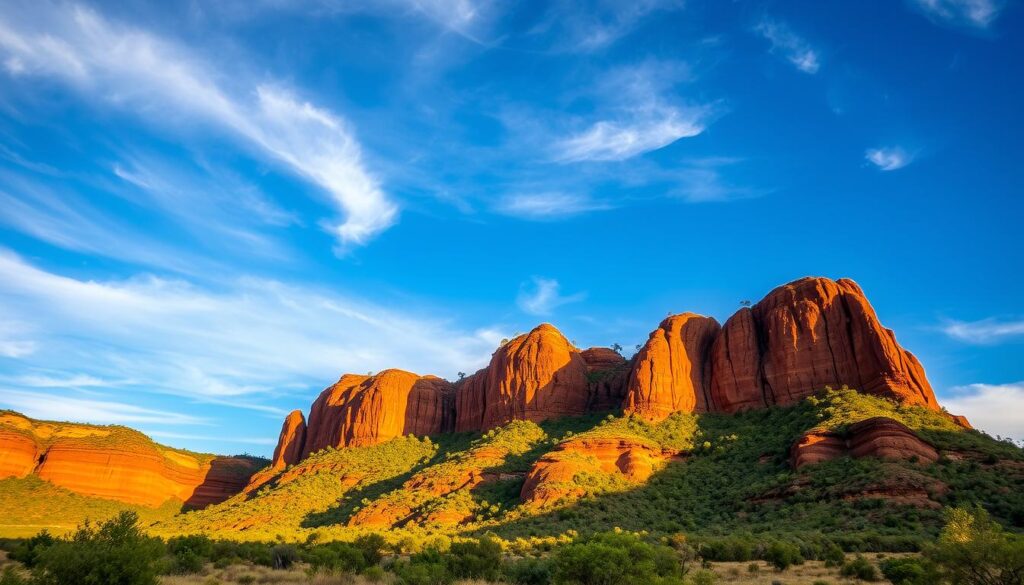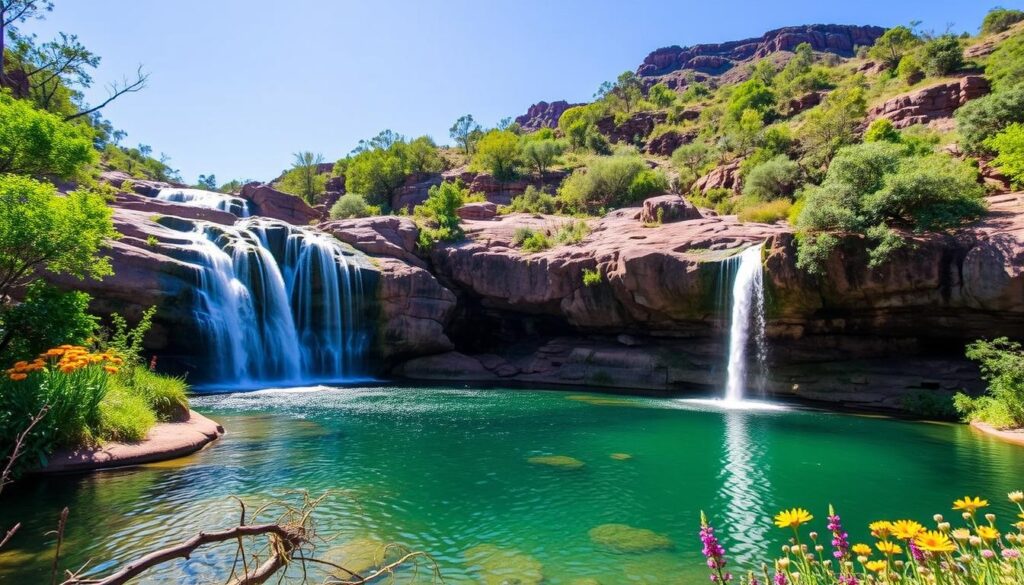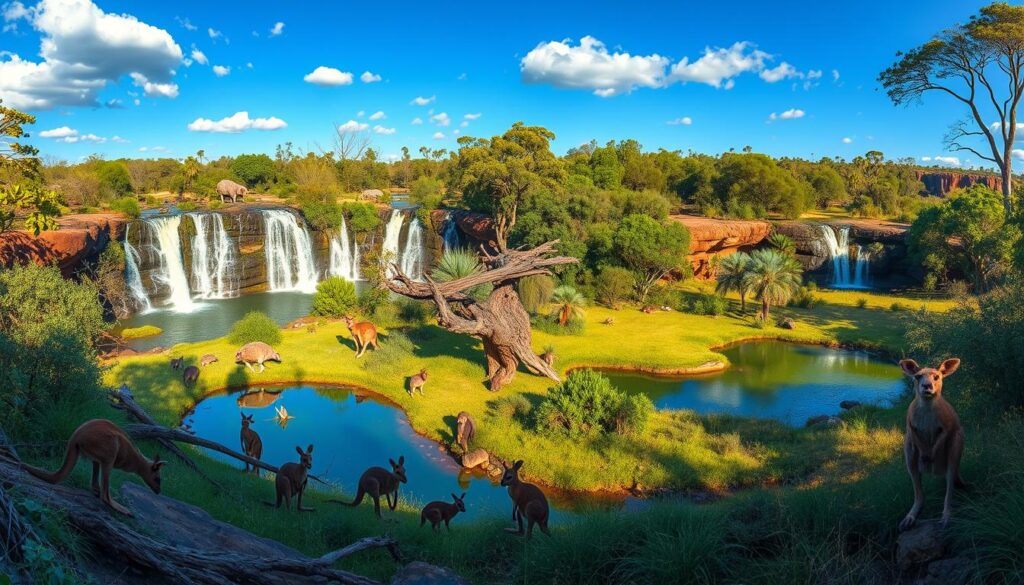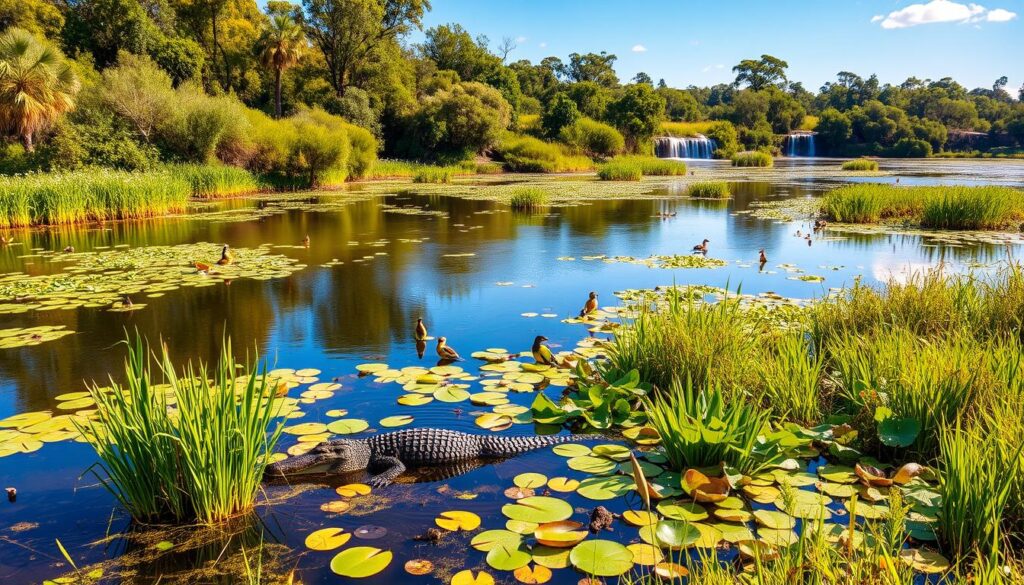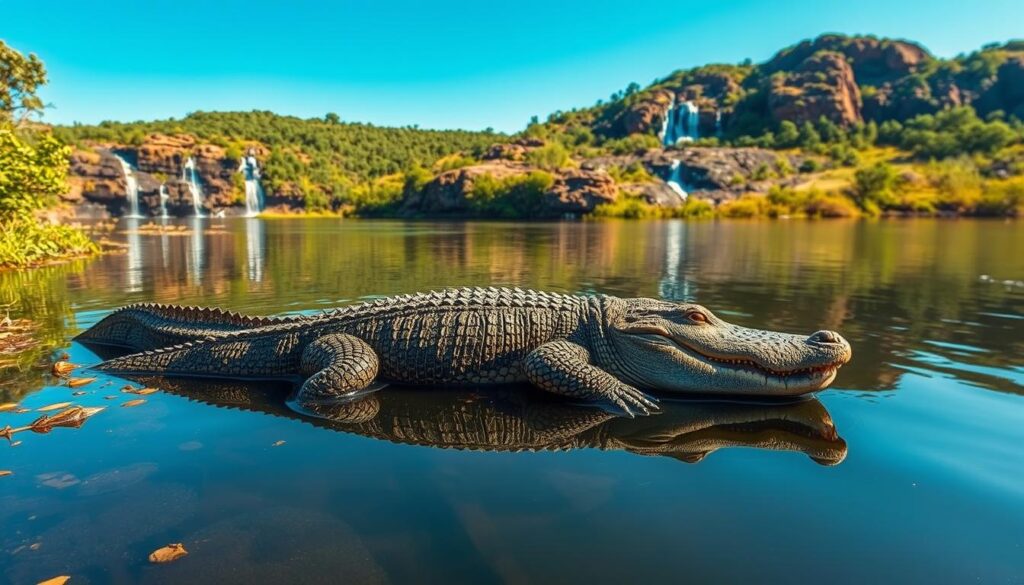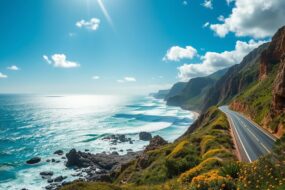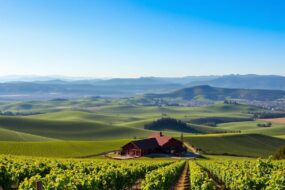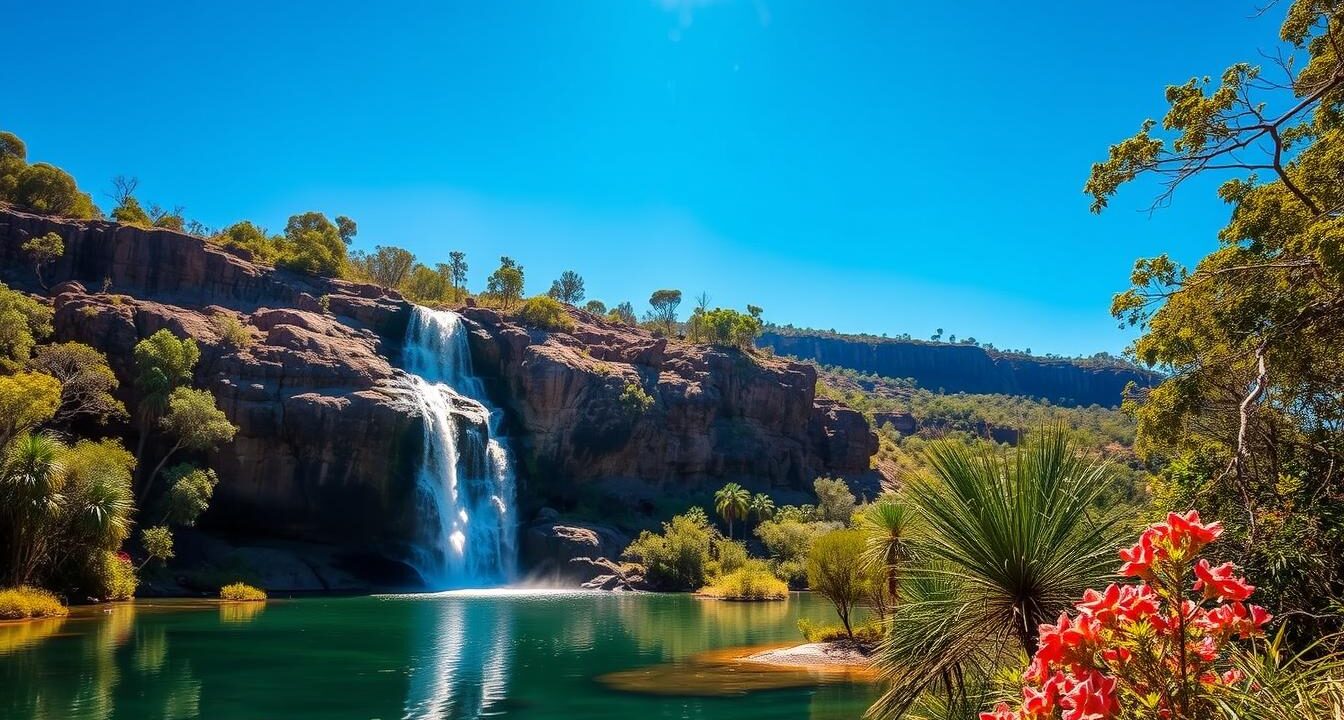
When I first stepped into Kakadu National Park in Australia’s Northern Territory, I was struck by its beauty. The park’s vast landscapes, from waterfalls to wetlands, were full of life. It was a UNESCO World Heritage Site, rich in Aboriginal history and natural wonders. I had always wanted to see it, and now I was here to explore.
Kakadu National Park covers nearly 20,000 square kilometers. It’s a true treasure in the Northern Territory. Here, you can see the region’s natural beauty and the bond between the land and its indigenous people. From Jim Jim Falls to Yellow Water Billabong, it offers adventures for everyone. Whether you love bushwalking or want to see wildlife and Aboriginal rock art, Kakadu has it all.
Key Takeaways
- Kakadu National Park is a UNESCO World Heritage Site in Australia’s Northern Territory, renowned for its diverse landscapes and wildlife.
- The park covers nearly 20,000 square kilometers and features breathtaking waterfalls, wetlands, and sandstone escarpments.
- Visitors can explore Aboriginal rock art sites, go bushwalking, and spot over 280 bird species and one-fifth of Australia’s mammals.
- Kakadu’s dramatic seasonal changes offer unique experiences, from the Dry Season’s peaceful billabongs to the Wet Season’s thundering waterfalls.
- The park is managed jointly by Aboriginal traditional owners and Parks Australia, preserving its rich cultural heritage and natural wonders.
Introduction to Kakadu’s Natural Wonders
Kakadu National Park is in the heart of Australia’s Northern Territory. It attracts visitors from all over the world. This vast area is known for its amazing biodiversity, stunning landscapes, and rich culture.
World Heritage Status and Significance
Kakadu National Park is a UNESCO World Heritage site. It’s celebrated for its natural and cultural wonders. The park’s diverse ecosystems, like floodplains and sandstone escarpments, make it a true ecological treasure.
Geographic Location in Northern Territory
Kakadu National Park is in the Northern Territory. It’s Australia’s largest national park and one of the biggest in the tropics. Its location in the Top End lets visitors see many different habitats and experience the park’s unique contrasts.
Park’s Unique Ecosystem Overview
Kakadu’s biodiversity is impressive. It has many ecosystems, like savannas and mangroves. These habitats support over 1,600 plant species, 77 mammals, 132 reptiles, and 280 birds.
| Ecosystem Type | Noteworthy Features |
|---|---|
| Wetlands and Billabongs | Internationally recognized Ramsar-listed wetlands, including the iconic Yellow Water Billabong |
| Sandstone Escarpments | Dramatic cliffs up to 330 meters high, offering stunning views and unique habitats |
| Savanna Woodlands | Home to a diverse array of wildlife, including the iconic kangaroo and wallaby |
Kakadu National Park is a natural wonder. Its diverse ecosystems and biodiversity make it a place worth exploring. It’s a must-see for nature lovers and adventure seekers.
Dramatic Seasonal Changes in Kakadu
Kakadu National Park in the Northern Territory of Australia is a natural wonder. It goes through dramatic seasonal changes. This UNESCO World Heritage site shows a remarkable transformation. The wet and dry seasons greatly affect its wetlands, billabongs, wildlife, and waterfalls.
In the wet season, Kakadu’s floodplains come alive with vibrant colors and lots of wildlife activity. The park’s diverse ecosystems thrive, with migratory birds flocking to the wetlands and billabongs. When it’s dry, habitats shrink, making bird activity in places like the Mamukala wetlands more intense.
The park’s waterfalls change a lot with the seasons. They flow slowly in the dry season but roar in the wet. Visitors can see this change by taking scenic flights over the park. They get to see the waterfalls in both calm and powerful states.
Kakadu’s changing seasons shape its landscape and affect its wildlife. From saltwater crocodiles to black wallaroos, the animals adapt to the changes. This gives visitors a unique and changing view of nature’s adaptability.
Magnificent Waterfalls of Kakadu National Park: Wildlife and Waterfalls
Kakadu National Park is famous for its stunning waterfalls. Each waterfall offers a special experience for visitors. From the high cascades of
Jim Jim Falls
and
Twin Falls
to the natural infinity pool at
Gunlom Falls
, these wonders show the park’s dramatic changes and richwildlife and waterfalls.
The Jim Jim Falls and Twin Falls are top spots in Kakadu. They draw many adventurers who want to feel the mist of these powerful falls. In the wet season, they roar with water. In dry months, they are calm and cool for Bushwalking lovers.
For a quiet spot, check out
Motor Car Falls
. It’s hidden in lush monsoon forests. This waterfall is peaceful, with chances to see many animals and waterfalls.
“The waterfalls in Kakadu National Park provide distinct experiences, with different access methods ranging from clambering over rocks to following civilised bush tracks.”
One of the park’s most famous waterfalls is
Gunlom Falls
. It offers a special and amazing experience. At the top, there’s a natural infinity pool with views of Kakadu’swildlife and waterfalls.
Kakadu’s waterfalls are perfect for adventure or quiet moments. They will amaze and inspire everyone who visits this natural wonder.
Native Wildlife and Biodiversity
Kakadu National Park in the Northern Territory, Australia, is a wildlife paradise. It covers 20,000 square kilometers and is home to many native species. You can see agile wallabies, flying foxes, and even rare Leichhardt’s grasshoppers and pig-nosed turtles.
The park has different habitats like wetlands, billabongs, rocky escarpments, and dense forests. These places support many animals, including large mammals, aquatic reptiles, and river sharks. Kakadu is key in protecting the Northern Territory’s natural heritage.
Kakadu has 2,000 plant species, one-third of Australia’s birds, and about one-fifth of its mammals. This shows the park’s natural value. It was named a UNESCO World Heritage site in 1981.
Visitors can see amazing wildlife like the northern quoll and saltwater crocodile. It’s a top spot for nature lovers and wildlife enthusiasts.
Wetlands and Billabong Ecosystems
Kakadu National Park is famous for its wetlands and billabongs. These areas are key for many animals. They show the park’s amazing natural beauty.
Yellow Water Billabong
The Yellow Water Billabong is a highlight in the park. Visitors can see it on guided boat tours. They might spot saltwater crocodiles and colorful waterlilies.
Mamukala Wetlands
The Mamukala Wetlands are another gem in Kakadu. Here, bird hides let visitors see thousands of migratory magpie geese. It’s a great spot for bird watching.
Home Billabong
The Home Billabong is a special place in the park. A boardwalk and viewing platform let visitors see many animals. Look out for jacanas, egrets, and jabirus.
These wetlands and billabongs are full of life. They offer great chances for bird watching and wildlife photography. They prove Kakadu’s importance as a natural wonder.
Crocodiles and River Life
Kakadu National Park is home to many crocodiles, both saltwater and freshwater. These creatures are a big part of the park’s river life. People from all over come to see them in their natural home.
Yellow Water Billabong is a great place to see crocodiles. They hide among water lilies, watching for food. The park has warning signs to keep visitors safe from the water.
Crocodiles are a big draw, but they remind us of nature’s power. Sadly, they have hurt some visitors. The park urges everyone to stay careful and follow safety rules when near water.
| Crocodile Facts | Key Statistics |
|---|---|
| Saltwater crocodiles are the largest living reptiles, with some reaching over 7 meters in length. | Kakadu National Park covers 3,600 square miles and is owned by the Gagudju Aborigine tribe. |
| Freshwater crocodiles can be found in the park’s rivers, lakes, and billabongs, growing up to 3 meters long. | The park boasts over 1,000 varieties of plant life and hundreds of reptiles, birds, and mammals. |
| Crocodile skins from the Northern Territory can sell for $250 or more apiece. | Kakadu National Park attracts around 200,000 visitors annually, with crocodiles being a significant draw. |
When exploring Kakadu’s waterways, visitors must stay alert and follow safety rules. This way, they can enjoy the Crocodiles, wildlife, and waterfalls of the Northern Territory safely.
Bird Watching Paradise
Kakadu National Park is a bird lover’s dream, with over 280 bird species. It has wetlands, billabongs, and sandstone escarpments. These places offer great chances to see many birds all year.
Migratory Species
Every year, many migratory birds come to Kakadu’s wetlands and billabongs. The magpie geese are a highlight. They come for food and to nest, making it a treat for visitors.
Endemic Birds
Kakadu is also home to unique birds like the hooded parrot. These birds are found only in this park. Seeing them makes bird watching in Kakadu even more special.
Best Viewing Locations
- Mamukala Wetlands: It’s full of waterfowl and wading birds, perfect for bird watching.
- Yellow Water Billabong: Here, you can see many birds, including raptors and kingfishers.
- Home Billabong: It’s surrounded by greenery and attracts many birds, making it a favorite spot for birders.
Kakadu National Park is a must-visit for bird watching. It offers birdwatching tours and a chance to see many bird species. It’s a place where you can enjoy the beauty of Australian bird watching, wetlands, wildlife, and waterfalls.
Sandstone Escarpments and Stone Country
Kakadu National Park’s rugged stone country borders Arnhem Land. It’s a breathtaking landscape for hikers and nature lovers. This rocky terrain stretches from the northern Ubirr area to the southern Nourlangie region. It’s home to ancient Aboriginal rock art sites, showing the area’s rich cultural heritage.
The stone country highlights Kakadu’s geological diversity. It contrasts sharply with the park’s wetlands and forests. This unique environment is a haven for rare wildlife, like the black wallaroo and giant cave gecko. For those looking for an adventurous bushwalking experience, the stone country offers challenging trails. These trails lead to stunning views and hidden natural wonders.
“The stone country of the Arnhem Land plateau was created 1650 million years ago, and the southern hills and ridges of Kakadu National Park were formed over 2500 million years ago due to volcanic activity.”
Kakadu National Park covers 20,000 square kilometers. It’s a true geological wonder with seven distinct eco-regions. Each region offers unique features and attractions. From ancient rock art sites to towering sandstone escarpments, Kakadu’s stone country is a testament to its rich heritage. It invites visitors to explore the Northern Territory Australia.
The stone country of Kakadu National Park is a treasure trove of natural and cultural wonders. It showcases the park’s rugged beauty and the enduring connection between Aboriginal people and their land. This connection has lasted for thousands of years.
Aboriginal Cultural Connection
Kakadu National Park in the Northern Territory of Australia is home to a rich Aboriginal rock art and culture. The Bininj/Mungguy people have lived here for over 65,000 years. The park’s wildlife and waterfalls are closely tied to their traditions.
In the stone country of Kakadu, ancient rock art tells stories of the past. Local guides take visitors on cultural tours. They share how the land has supported the Bininj/Mungguy people for thousands of years.
“Respecting culture involves not entering restricted areas which may be sacred sites, ceremonial locations, burial grounds, or private residences in Aboriginal communities.”
Kakadu’s World Heritage status highlights its cultural importance. Visitors learn about the Bininj/Mungguy way of life. They discover the skin name system and the importance of saying “bobo” when leaving.
Despite colonization’s challenges, the Bininj/Mungguy culture thrives in Kakadu. It offers a chance to connect with one of the world’s oldest cultures.
Visitor Safety and Wildlife Viewing Tips
Kakadu National Park is a wildlife wonderland. It’s home to many species, like Crocodiles and great Bird Watching spots. To have a safe and fun visit, follow these tips.
Best Times for Wildlife Spotting
Go out early in the morning or at sunset for the best wildlife views. This is when animals are most active. Bring a torch or flashlight for night creatures. Listen for sounds and look for tracks as you Bushwalking.
Safety Guidelines
- Keep a safe distance from all wildlife, like crocodiles, snakes, pigs, and buffaloes.
- Follow all crocodile warning signs and don’t approach these powerful predators.
- Stay on marked trails and paths, and always be aware of your surroundings.
- Think about joining a group or guide for more remote hikes.
Photography Tips
Kakadu National Park is perfect for Crocodiles, Bird Watching, and Bushwalking photos. Use the right lenses to respect wildlife from afar. The golden light of early morning and late afternoon makes for beautiful photos.
“Kakadu National Park is a photographer’s paradise, with its dramatic landscapes, diverse wildlife, and ever-changing scenery. Embrace the elements and capture the essence of this truly unique Australian wilderness.”
Conclusion
Kakadu National Park in the Northern Territory of Australia is a true marvel. It’s a UNESCO World Heritage site, covering over 20,000 square kilometers. This area shows Australia’s incredible biodiversity and the deep bond between the land and its Indigenous people.
The park’s waterfalls, like Jim Jim Falls, are breathtaking. The Yellow Water billabong is full of wildlife. Kakadu offers a world of natural beauty. The changing seasons add to the park’s charm, making every visit unforgettable.
Kakadu is also famous for its indigenous rock art. It’s one of the largest collections in the world. This art gives us a glimpse into the Aboriginal people’s traditions and culture. Hiking or birdwatching here leaves visitors amazed by the park’s natural and cultural wonders.

